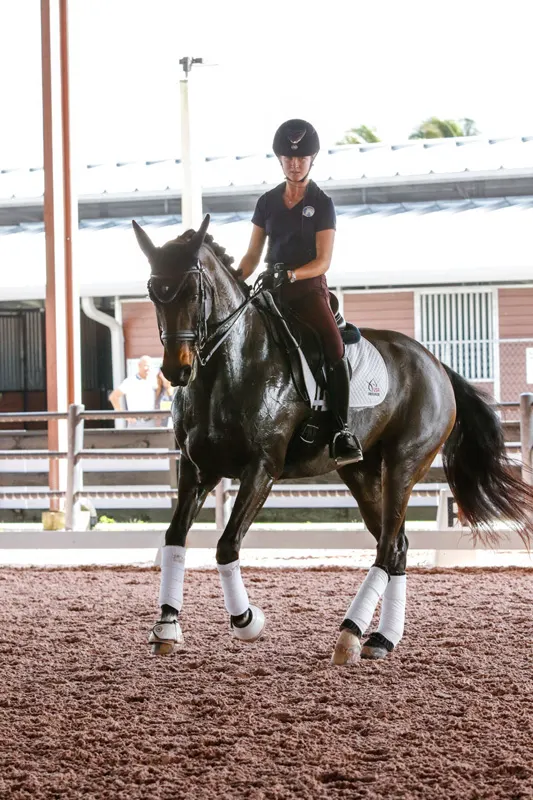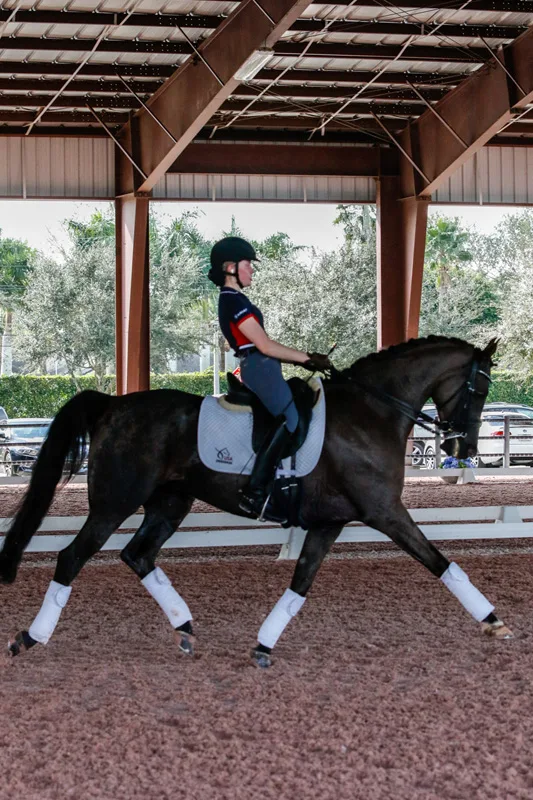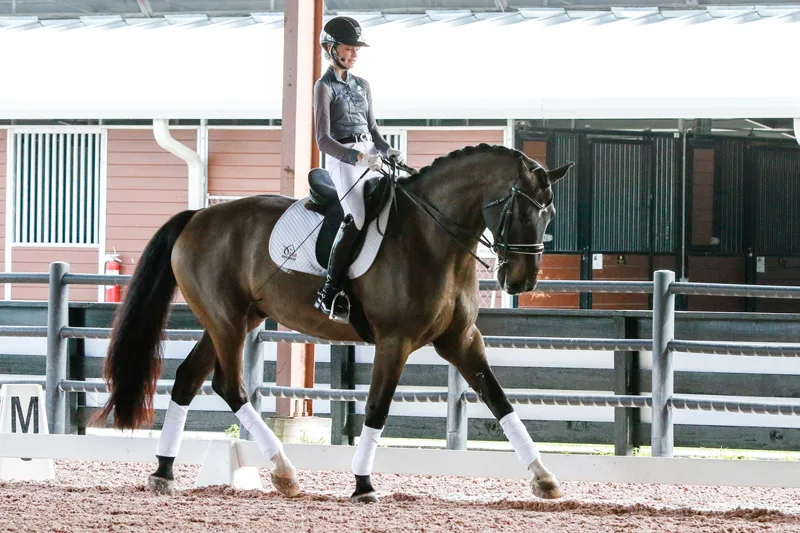Wellington, Fla.—Jan. 6
Katherine Bateson-Chandler, Robert Dover and George Williams can’t help it when pearls of wisdom fall from their lips. After all, they are dressage superstars. And, as the trainers for the 2020 Robert Dover Horsemastership Week, they shared their expertise with the talented young riders and spectators at the Adequan Global Dressage Festival showgrounds.
On Day 2, Bateson-Chandler coached Callie Jones of Henderson, Kentucky, on her own Don Philippo, a 12-year-old Hanoverian (Dancier—Wildnight) gelding. Although Jones rides “Phil” in the small tour, her goal is to contest the Under-25 division. So what was Bateson-Chandler’s advice?
“Make sure you’re thinking Grand Prix,” she said. “Like when you pick him up to this collected walk, you’ve got to think, ‘OK, if I was in a Grand Prix, would I be able to go around that corner and do a passage?’ I know your horse doesn’t know these things yet, but those are the thoughts in your head. You’ve got to keep training every day to Grand Prix. Like even when I’m on my 4- or 5-year-old, I’m like, ‘OK, even though they’re babies, I’ve got to have the same expectations as I would have my Grand Prix horse.’ ”

Callie Jones worked on ensuring that even at the walk her horse was ready to perform any movement as soon as she asked for it. Sue Weakley Photos
When they worked on changes, Bateson-Chandler gave Jones some more advice. “When I’m not riding a tempi change, I count it out like it’s a tempi change, so my horse can feel my body language, and he knows three strides out when a change is coming,” she said. “So, if I was going to ride that single change, I would go to myself, ‘One, two, three, change.’ I want you to really count it out. Like it’s a jump. So you’ve got to know when you’re three strides out and then ride it on the course. And again, that just helps your body prepare. It’s like a show jumper.”
As they worked on walk pirouettes, Bateson-Chandler told Jones to feel like she was walking up a hill the entire time and that there was a cone behind her and she was walking around it. “Control the outside! Turn the shoulder, turn the shoulder, turn the shoulder, and walk out. You’ve got to see where that cone is, and you’re going to stay walking around it at an active walk.”
ADVERTISEMENT
Williams helped Hannah Irons from Queenstown, Maryland, on Scola Bella, the 11-year-old Hanoverian mare she leases from Dressage4Kids, (Scolari—Walona). He had some tips for their canter pirouettes. First, he told Irons to make sure she had the right response to the inside rein with her horse getting softer and more “in front” of the rider.
“It’s important that when you touch the inside rein, you get a very soft response,” he said. “You have to look up and remember to keep your shoulders back and ideally you connect her from your seat to your hand. After you do the pirouette, can you give just a little bit so that you’re lighter, and she doesn’t have anything to lean and brace against? And, I know this is the challenge, but can you make the arc of the turn just a little bit bigger? In doing that, you have to keep the forehand coming around.”
When Irons wanted her horse to go forward, Williams suggested she use more leg rather than the whip.
“The whip is not used necessarily to correct her because she’s not quick enough off your leg,” he said. “Think of the whip as its use is really to make her quicker in general and quicker in her step, but not necessarily to reinforce the leg per se. Because you’re not going to have the whip in competition, make sure that if you use your leg and she doesn’t go, you follow through with a stronger leg aid, which ends up being more of a kick. So then she gives you the response you want from your leg. The whip can be used to make her a little quicker if you want to go toward half-steps. If the whip is used to reinforce the leg, it’s used as a sort of punishment. If you go into competition and drop the whip, she knows you can’t follow through, so you have to be sure and follow through with your leg aids.”
Bateson-Chandler also shared advice on whip use with Lucie Bacon from Atherton, California, who was riding Hemmi, advising her that if she uses the whip, to make sure it really means something. “Not that he’s sort of behind you, and you start ticking away with that whip. Either use it or don’t use it. And if you use it, make sure you get a response and then don’t use it again.”
When it was time for a walk break, Bateson-Chandler told her to be aware of the quality of the walk.
ADVERTISEMENT
“Make sure when you’re walking you’re really thinking about the walk,” she said. “Be aware of your walk the whole time you’re on him. If you’re in an extended walk, you want his nose in front of the vertical. And ears level with his withers. That’s what you’re going to think about in front of you. So you want to keep growing that neck forward so you push it away. How big can I get him swinging over his back? And again, the same rules apply in the walk as anything else. If you talk to him with an aid, he’s got to answer.”
And when it came to flying changes, Bateson-Chandler also gave general advice about the canter.
“You’ve got to remember that your flying change is just another canter stride, and if you don’t have a very good canter, you’re not going to have a good flying change. So, you’ve got to make sure you’ve got a canter that’s jumping, jumping and jumping,” she said, adding that if the horse is a bit behind the leg or crooked, the flying change is not going to be stellar.
“It’s like riding toward a show jump,” Bateson-Chandler added. “You have to come at that jump like, ‘I see it. I am riding it. We’re going over guys.’ Same thing with the flying change. You’ve got to be positive.”
Bateson-Chandler also gave sage advice about a horse’s center of gravity. “Always ride that inside hind leg under his tummy because right under the girth is where his center of gravity is, and you want to balance on his inside hind leg. So, you’ve got to make his inside hind leg go in the middle of his girth at all times. That’s forever with all horses. You’ve got to really keep their inside hind leg toward the middle of the girth, and you’ll have an uphill balance. And if they’re not balanced, they’re always going to be sort of tipping down into your hands.
Williams reiterated to Annelise Klepper of McCutchenville, Ohio, who rode Shannon Klepper’s 13-year-old Oldenburg gelding Happy Texas Moonlight (Happy Diamond—Texane), the often-heard advice about the hallowed half-halt from all the trainers.
“An exercise has to have the desired outcome, but you have to be there with the half-halts and be there with the suppling,” he said. “Did the half-halt have its desired effect? In other words, did he carry more weight? A little bit more elevated in front? If you half-halted him, and he feels exactly the same at the next stride, it didn’t do anything. If you need to make him more through, don’t be afraid to be firm for a step. Get the response!”

















